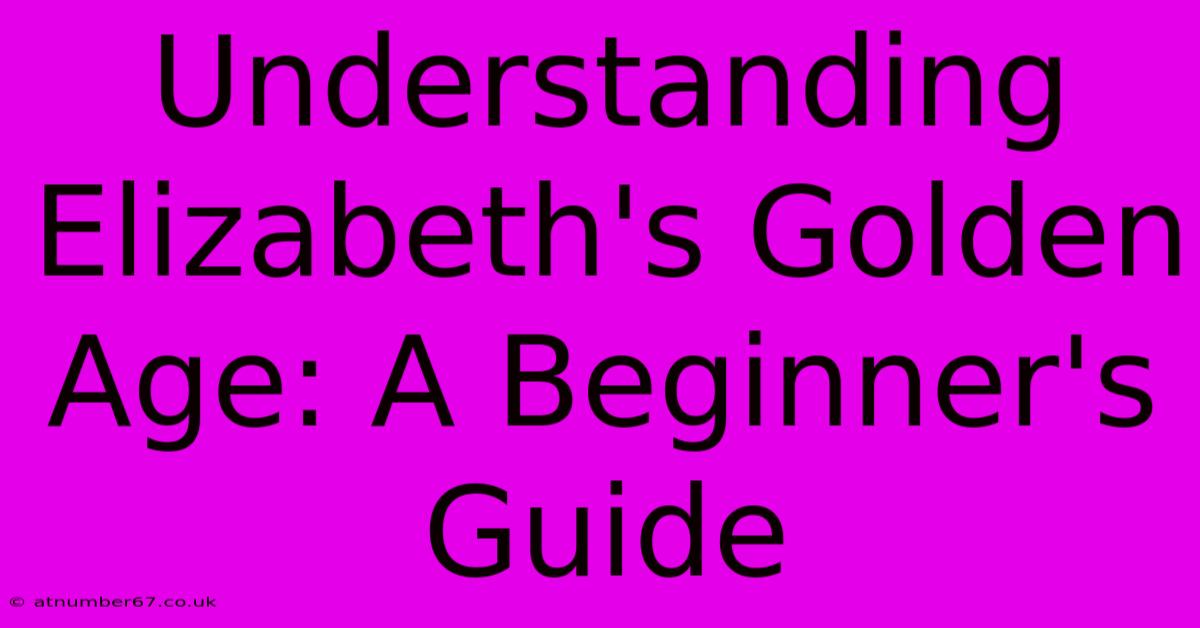Understanding Elizabeth's Golden Age: A Beginner's Guide

Table of Contents
Understanding Elizabeth I's Golden Age: A Beginner's Guide
England's Elizabethan era (1558-1603), the reign of Queen Elizabeth I, is often romanticized as a "Golden Age." But what exactly made it so golden? This beginner's guide delves into the key aspects that shaped this significant period in English history.
The Political Landscape: Stability and Power
Elizabeth's reign began amidst religious turmoil. Her predecessor, Mary I, had attempted to restore Catholicism, leading to widespread persecution. Elizabeth, a Protestant, skillfully navigated the religious divide. Her religious policy, known as the Elizabethan Religious Settlement, aimed for a balance, establishing a moderate Protestant church while tolerating some Catholic practices. This pragmatic approach brought a degree of religious stability, crucial for the nation's peace and prosperity.
Key Political Achievements:
- Defeating the Spanish Armada (1588): This naval victory solidified England's position as a major European power and boosted national pride. It marked a turning point, shifting the balance of power away from Spain and towards England.
- Establishing a strong centralized government: Elizabeth worked to consolidate royal power, enhancing the authority of the monarchy and creating a more efficient administrative system.
- Patronage and diplomacy: Elizabeth skillfully used patronage to cultivate loyalty amongst her nobles and employed shrewd diplomacy to maintain peace and avoid costly wars whenever possible, except when absolutely necessary for national security.
Economic Prosperity: The Rise of Mercantilism
The Elizabethan era witnessed significant economic growth. The implementation of mercantilist policies fueled overseas trade, particularly with the newly discovered Americas. This led to an influx of wealth and resources, bolstering the English economy.
Key Economic Factors:
- Exploration and colonization: The establishment of colonies in North America opened up new trade routes and provided access to valuable resources, contributing to England's burgeoning wealth.
- Growth of London: London experienced significant population growth and became a major center of commerce and finance, attracting merchants and entrepreneurs from across the country.
- Increased textile production: The wool industry thrived, making England a leading producer of textiles in Europe.
Cultural Flourishing: The Arts and Literature
The Elizabethan era is renowned for its extraordinary cultural achievements. This period saw a flourishing of art, literature, music, and theater, which continues to influence and inspire creators even today.
Highlights of Elizabethan Culture:
- William Shakespeare: Arguably the greatest writer in the English language, Shakespeare's plays and sonnets remain timeless classics, capturing the spirit and complexities of the Elizabethan age. His works explored themes of love, ambition, betrayal, and revenge that resonate with audiences centuries later.
- Other notable writers: Besides Shakespeare, other literary giants like Christopher Marlowe, Edmund Spenser, and Ben Jonson contributed to the richness of Elizabethan literature.
- Architectural advancements: The era saw magnificent architectural developments, reflecting the wealth and power of the time. The building of grand houses and stately homes showcase the era's sophisticated architectural styles.
- Musical innovations: Music flourished, with composers developing new styles and forms. Madrigals and other musical genres gained popularity during this time.
The Legacy of the Golden Age
Elizabeth's reign left an indelible mark on England's history. Her shrewd leadership, combined with favorable economic conditions and a vibrant cultural scene, created a period of remarkable progress and prosperity. The legacy of this "Golden Age" continues to shape English national identity and serves as a reminder of England's rich past. Understanding this era is crucial to understanding the trajectory of England's place in the modern world. The many achievements of this time period continue to resonate and influence the UK and the wider world today.
Further Research:
For those who want to delve deeper, exploring primary sources such as letters and diaries from the period can provide fascinating insights. Biographies of Elizabeth I and other key figures of the time offer valuable perspectives. Examining the art, literature, and music of the era can provide a richer understanding of the cultural landscape. Exploring the historical context of events like the defeat of the Spanish Armada also enriches one’s knowledge and appreciation of this fascinating historical period.

Thank you for visiting our website wich cover about Understanding Elizabeth's Golden Age: A Beginner's Guide. We hope the information provided has been useful to you. Feel free to contact us if you have any questions or need further assistance. See you next time and dont miss to bookmark.
Featured Posts
-
Mark Alcalas Age A Model For Future Generations
Mar 29, 2025
-
The Couples Journey Athiya Shetty And Her Husband
Mar 29, 2025
-
Joshua Jacksons Daughter A Mothers Inspiration
Mar 29, 2025
-
Dads Army Cast Never Before Seen Photos
Mar 29, 2025
-
Dembeles Age And The Expectations On Him
Mar 29, 2025
